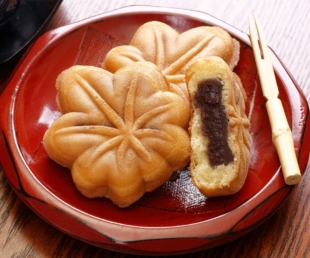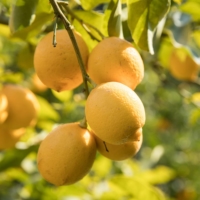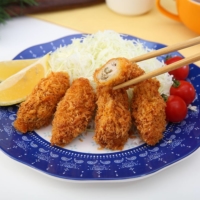Situated on the western tip of Honshu between the Sea of Japan and the Seto Inland Sea, the climate of Hiroshima Prefecture is one of contrasts, with a northern side chilled by cold currents and a southern side that stays mild and warm. The mountainous areas see snow and the coastal areas can get plenty of rain, promoting the farming and fishing that give the region its unique delicacies.
Bounty from land, sea
Hiroshima’s most famous product may be its oysters. The prefecture accounts for 60% to 70% of the nation’s farmed oysters, and they are plentiful in the local cuisine. Oysters are available all around the city and in other towns throughout the prefecture. They are eaten raw with ponzu vinegar (a citrus-based soy sauce) or plain soy sauce, breaded and deep-fried, grilled, baked, served on rice, and more. Oysters are so popular there that they are available year-round. One local specialty that uses oysters is dotenabe (hot pot), a fixture on dinner tables during the colder months. The insides of the earthenware pots are coated with dote, a bank of paste made with miso and other seasonings, while a mixture of leeks, napa cabbage, shiitake and other vegetables is blended with tofu, oysters and soup stock in the pot. The dish is eaten as the bank of miso melts into the center, providing a rich and comforting umami-filled treat.
Hiroshima-style okonomiyaki (a savory Japanese meat and vegetable pancake) is another dish that often includes oysters.
Hiroshima okonomiyaki differs from the better-known Osaka variety in that the ingredients are not mixed with the batter. Instead, a thin pancake is made, which is then loaded up with chopped cabbage and fried noodles. These are then topped with ingredients ranging from oysters and squid to pork belly and cheese, and finished off with katsuobushi (bonito flakes), ao-nori (green seaweed flakes), and salty-sweet okonomiyaki sauce. The dish is so popular that there is an area around Hiroshima Station called Okonomimura (Okonomi Village) that is packed with restaurants serving this local favorite. Typically, the chef makes the okonomiyaki in front of you and serves it piping hot right off the griddle.
The mild climate along the Seto Inland Sea is especially suited to the production of citrus, and the lemons grown here, called Setouchi lemons, are highly regarded for their juiciness and quality. It is thought that the first lemon trees were planted in the region in 1898, when a shipment of navel orange saplings from Wakayama Prefecture mistakenly contained some lemon trees. That happy accident has led to a thriving industry. As with oysters, Hiroshima dominates the lemon market in Japan, with more than 60% of domestic production.
Lemons are enjoyed both ripe and unripe throughout much of the year. They can be found in local specialties, such as cakes shaped like lemons and stuffed with lemon jam; tart lemon gelato made with fresh lemon juice; a variety of lemon beverages and more. Lemons are used abundantly in the local cuisine as a condiment, and you can find lemon condiments such as a lemon and salt paste called namashio (raw salt) lemon, and a similar liquid product called Lemosco to take home as gifts. They are even used to make a local type of pressed marinated sushi called lemon leaf sushi from the town of Onomichi, where lemon peel is included in the rice itself, and lemons are used to marinate the fish instead of the usual vinegar. The sushi is then wrapped in fragrant lemon leaves.
Diverse culinary variety
Regarding Onomichi, a side trip to this picturesque town is warranted for its steep paths offering fantastic views of the Seto Inland Sea, but another great reason to visit is its ramen, which is renowned around the country. Onomichi ramen has a chicken and seafood soup base that is made dark, almost black, by the addition of a soy-based sauce. The noodles are thick and hearty with a slippery texture that fans find irresistible. Onomichi is also famous for its own type of okonomiyaki, called Onomichiyaki. Although it’s similar to Hiroshima’s variety, it is identified by the inclusion of such chewy, down-to-earth ingredients as chicken gizzards and squid tempura.
The city of Hiroshima has its own type of ramen, too, characterized by a light soup based on pork and chicken bones and seafood, lightly seasoned with soy sauce. The noodles are on the thin side, and ramen aficionados regard it as combining the best qualities of hearty Kyushu-style pork bone ramen and Tokyo-style ramen, which has a soy sauce base. Comparing Onomichi ramen with Hiroshima ramen is a must for any serious ramen gourmet.
As alternative is tsukemen, a type of ramen where the noodles are dipped into a well-flavored sauce rather than served in soup. Hiroshima tsukemen is served cold with a salty-sour chili pepper sauce. The sauce varies in spiciness, and diners can select the degree. Tsukemen is eaten with various toppings, including slices of char siu (roasted or boiled pork), boiled eggs, green onions, cabbage and cucumber. Hiroshima tsukemen is great when the weather is hot or cold, and makes a great end of to a night of bar-hopping.

The sweet tooth is certainly not neglected in Hiroshima. Besides the aforementioned lemon cakes and lemon gelato, a famous Hiroshima specialty is momijimanju, or maple leaf dumplings. This is a pretty little cake made with a pancake-like batter that is usually filled with anko (sweet adzuki bean paste) and shaped like a maple leaf. They are a specialty of Miyajima (also known as Itsukushima), the island famous for its bright red Grand Torii Gate that seems to float in the sea at high tide, as well as its sacred Shinto shrines and Buddhist temples.
The momijimanju was created in the early 1900s as a symbol of Momijidani (Maple Valley), which is renowned for its spectacular red maple foliage in the fall. Momijimanju are lightly sweet, and perfect with a cup of tea. Momijimanju can be found at many shops in the city of Hiroshima as well as on Miyajima. Besides sweet bean paste, there are ones filled with custard or chocolate cream, too.
There are many other delicacies to enjoy in Hiroshima Prefecture, such as anagomeshi (grilled sea eel) served on rice, another Miyajima specialty; curry rice made famous by the Imperial Japanese Navy in the port city of Kure; and small fresh sardines served as tempura or sashimi. Thanks to the abundance of seafood from the prefecture’s productive waters, as well as the vegetables, fruit and other bounties of the land, wherever people go in Hiroshima they will be sure to encounter tasty and memorable meals and delectable snacks.



























With your current subscription plan you can comment on stories. However, before writing your first comment, please create a display name in the Profile section of your subscriber account page.